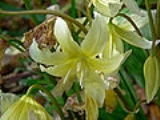
Erythronium californicum
Encyclopedia
Erythronium californicum is a species of flowering plant in the lily family
which is known by the common name California fawn lily.
It is endemic to the northern California Coast Ranges mountains of Northern California
.
3 to 6 centimeters wide and produces two basal leaves which are green and sometimes spotted with brown. The reddish-green stalks grow up to 30 centimeters tall and each bears one to three flowers.
The flower has yellowish-white tepal
s 2 to 4 centimeters long, sometimes with red or brown banding or striping toward the bases. The stamen
s, anthers, and stigma
are whitish in color.
Liliaceae
The Liliaceae, or the lily family, is a family of monocotyledons in the order Liliales. Plants in this family have linear leaves, mostly with parallel veins but with several having net venation , and flower arranged in threes. Several have bulbs, while others have rhizomes...
which is known by the common name California fawn lily.
It is endemic to the northern California Coast Ranges mountains of Northern California
Northern California
Northern California is the northern portion of the U.S. state of California. The San Francisco Bay Area , and Sacramento as well as its metropolitan area are the main population centers...
.
Description
The Erythronium californicum plant grows from a bulbBulb
A bulb is a short stem with fleshy leaves or leaf bases. The leaves often function as food storage organs during dormancy.A bulb's leaf bases, known as scales, generally do not support leaves, but contain food reserves to enable the plant to survive adverse conditions. At the center of the bulb is...
3 to 6 centimeters wide and produces two basal leaves which are green and sometimes spotted with brown. The reddish-green stalks grow up to 30 centimeters tall and each bears one to three flowers.
The flower has yellowish-white tepal
Tepal
Tepals are elements of the perianth, or outer part of a flower, which include the petals or sepals. The term tepal is more often applied specifically when all segments of the perianth are of similar shape and color, or undifferentiated, which is called perigone...
s 2 to 4 centimeters long, sometimes with red or brown banding or striping toward the bases. The stamen
Stamen
The stamen is the pollen producing reproductive organ of a flower...
s, anthers, and stigma
Gynoecium
Gynoecium is most commonly used as a collective term for all carpels in a flower. A carpel is the ovule and seed producing reproductive organ in flowering plants. Carpels are derived from ovule-bearing leaves which evolved to form a closed structure containing the ovules...
are whitish in color.

